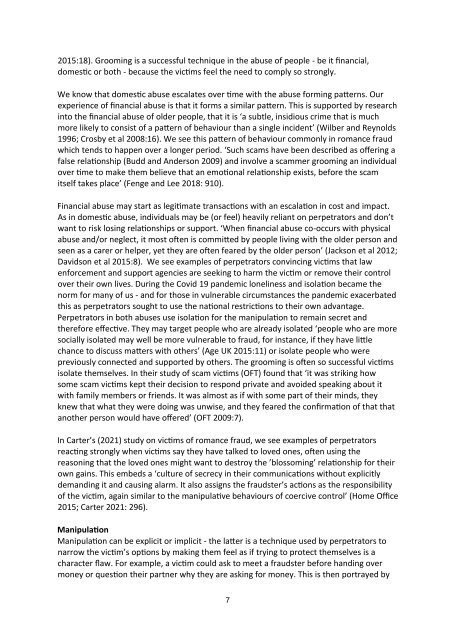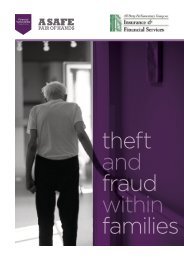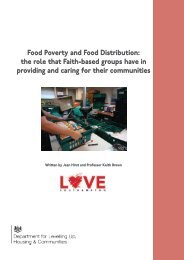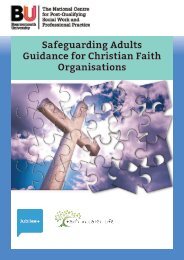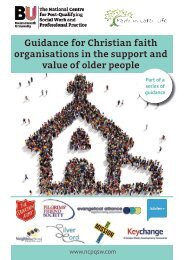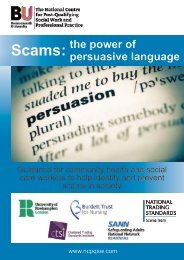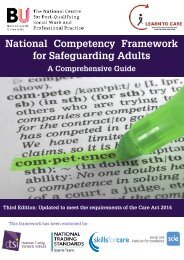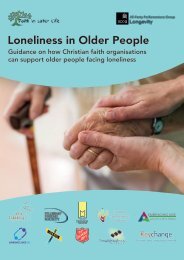0-Coercion and control report with pics FINAL
Coercion and control are used in both domestic and financial abuse. There are also differences in how agencies approach these concerns, and we seek to highlight this to learn from and utilise best practice.
Coercion and control are used in both domestic and financial abuse. There are also differences in how agencies approach these concerns, and we seek to highlight this to learn from and utilise best practice.
You also want an ePaper? Increase the reach of your titles
YUMPU automatically turns print PDFs into web optimized ePapers that Google loves.
2015:18). Grooming is a successful technique in the abuse of people - be it financial,<br />
domestic or both - because the victims feel the need to comply so strongly.<br />
We know that domestic abuse escalates over time <strong>with</strong> the abuse forming patterns. Our<br />
experience of financial abuse is that it forms a similar pattern. This is supported by research<br />
into the financial abuse of older people, that it is ‘a subtle, insidious crime that is much<br />
more likely to consist of a pattern of behaviour than a single incident’ (Wilber <strong>and</strong> Reynolds<br />
1996; Crosby et al 2008:16). We see this pattern of behaviour commonly in romance fraud<br />
which tends to happen over a longer period. ‘Such scams have been described as offering a<br />
false relationship (Budd <strong>and</strong> Anderson 2009) <strong>and</strong> involve a scammer grooming an individual<br />
over time to make them believe that an emotional relationship exists, before the scam<br />
itself takes place’ (Fenge <strong>and</strong> Lee 2018: 910).<br />
Financial abuse may start as legitimate transactions <strong>with</strong> an escalation in cost <strong>and</strong> impact.<br />
As in domestic abuse, individuals may be (or feel) heavily reliant on perpetrators <strong>and</strong> don’t<br />
want to risk losing relationships or support. ‘When financial abuse co-occurs <strong>with</strong> physical<br />
abuse <strong>and</strong>/or neglect, it most often is committed by people living <strong>with</strong> the older person <strong>and</strong><br />
seen as a carer or helper, yet they are often feared by the older person’ (Jackson et al 2012;<br />
Davidson et al 2015:8). We see examples of perpetrators convincing victims that law<br />
enforcement <strong>and</strong> support agencies are seeking to harm the victim or remove their <strong>control</strong><br />
over their own lives. During the Covid 19 p<strong>and</strong>emic loneliness <strong>and</strong> isolation became the<br />
norm for many of us - <strong>and</strong> for those in vulnerable circumstances the p<strong>and</strong>emic exacerbated<br />
this as perpetrators sought to use the national restrictions to their own advantage.<br />
Perpetrators in both abuses use isolation for the manipulation to remain secret <strong>and</strong><br />
therefore effective. They may target people who are already isolated ‘people who are more<br />
socially isolated may well be more vulnerable to fraud, for instance, if they have little<br />
chance to discuss matters <strong>with</strong> others’ (Age UK 2015:11) or isolate people who were<br />
previously connected <strong>and</strong> supported by others. The grooming is often so successful victims<br />
isolate themselves. In their study of scam victims (OFT) found that ‘it was striking how<br />
some scam victims kept their decision to respond private <strong>and</strong> avoided speaking about it<br />
<strong>with</strong> family members or friends. It was almost as if <strong>with</strong> some part of their minds, they<br />
knew that what they were doing was unwise, <strong>and</strong> they feared the confirmation of that that<br />
another person would have offered’ (OFT 2009:7).<br />
In Carter’s (2021) study on victims of romance fraud, we see examples of perpetrators<br />
reacting strongly when victims say they have talked to loved ones, often using the<br />
reasoning that the loved ones might want to destroy the ’blossoming’ relationship for their<br />
own gains. This embeds a ‘culture of secrecy in their communications <strong>with</strong>out explicitly<br />
dem<strong>and</strong>ing it <strong>and</strong> causing alarm. It also assigns the fraudster’s actions as the responsibility<br />
of the victim, again similar to the manipulative behaviours of coercive <strong>control</strong>’ (Home Office<br />
2015; Carter 2021: 296).<br />
Manipulation<br />
Manipulation can be explicit or implicit - the latter is a technique used by perpetrators to<br />
narrow the victim’s options by making them feel as if trying to protect themselves is a<br />
character flaw. For example, a victim could ask to meet a fraudster before h<strong>and</strong>ing over<br />
money or question their partner why they are asking for money. This is then portrayed by<br />
7


